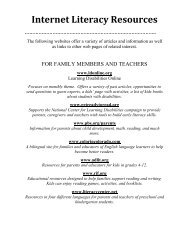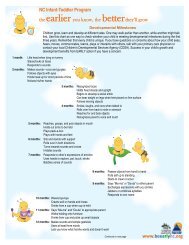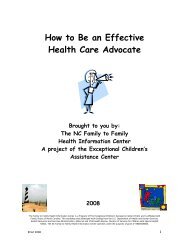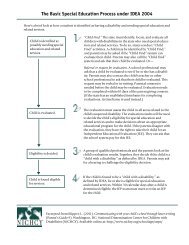Questions and Answers about IDEA - Exceptional Children's ...
Questions and Answers about IDEA - Exceptional Children's ...
Questions and Answers about IDEA - Exceptional Children's ...
You also want an ePaper? Increase the reach of your titles
YUMPU automatically turns print PDFs into web optimized ePapers that Google loves.
the need for special education. If a child is found toonly need a related service <strong>and</strong> not specialeducation, then he or she does not meet thedefinition of a “child with a disability.” 12Facactor E: Use of “Developmenelopmental Delaelays”<strong>IDEA</strong> allows States, at theirdiscretion, to adopt a definition of“child with a disability” thatincludes children aged 3 through 9(or any subset of that age range)who are experiencing “developmentaldelays” <strong>and</strong> “who, byreason thereof,” need specialeducation <strong>and</strong> related services. 13This provision allows States to find threethrough nine-year-olds (or any subset of that agerange) with developmental delays to be eligiblechildren with a disability <strong>and</strong> to provide them withspecial education <strong>and</strong> related services withouthaving to classify them under a specific disabilitycategory. This provision of law is intended toaddress the often difficult process of determiningthe precise nature of a child’s disability in the earlyyears of his or her development. 14According to <strong>IDEA</strong>, as measured byappropriate diagnostic instruments <strong>and</strong> procedures,“developmental delays” must be in one or more ofthe following areas:• physical development;• cognitive development;• communication development;• social or emotional development; or• adaptive development. 15States do not have to adopt use of the term“developmental delay” in their definitions of “childwith a disability.” It’s an option for States. Even ifthe State adopts the term (which includes definingthe age range of children to which it applies), itcan’t force any of its LEAs to do so. If the State doesnot adopt the term, its LEAs may not independentlydecide they will use the term. It’s only an option forLEAs if the State adopts the term—<strong>and</strong> then, theLEA must use the State’s definition, including theage range specified by the State. 16As you can see, the definition of “child witha disability” is intricate. Several factorsmust be met before a child can beconsidered to meet <strong>IDEA</strong>’sdefinition—<strong>and</strong> you must alsoconsider the specifics of yourState’s policies <strong>and</strong> definitions.3. Whahat t is special educaducation?Special education is defined as instruction that isspecially designed, at no cost to you as parents, tomeet your child’s unique needs. 17 Specially designedinstruction means adapting the content, methodology,or delivery of instruction:• to address the unique needs of your child thatresult from his or her disability, <strong>and</strong>1234 CFR §300.8(a)(2)—Child with a disability:General.Additional Note: If the related service the childneeds is defined by the State as special education(<strong>and</strong> not as a related service, as within <strong>IDEA</strong>),then the child would be considered as a “childwith a disability” after all.1334 CFR §300.8(b)—Child with a disability:Children aged three through nine experiencingdevelopmental delays.14Same as footnote 9. Adapted from page 1-28.1534 CFR §300.8(b)—Child with a disability:Children aged three through nine experiencingdevelopmental delays.1634 CFR §300.111(b)—Child find: Use of theterm developmental delay.1734 CFR §300.39(a)—Special education: General.NICHCY: 1.800.695.0285 6 <strong>Questions</strong> <strong>and</strong> <strong>Answers</strong> <strong>about</strong> <strong>IDEA</strong>
















